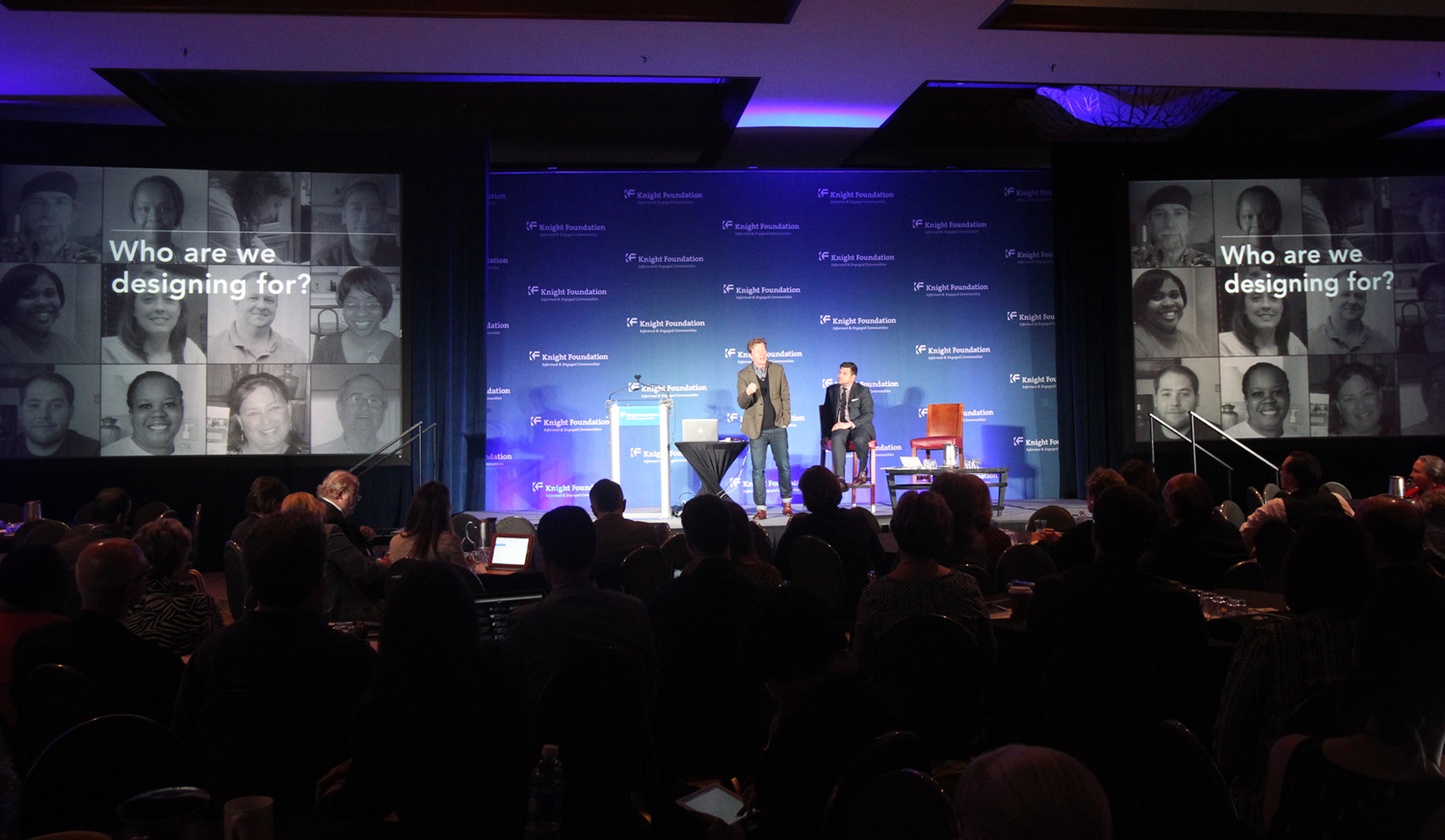
How human-centered design thinking can transform community media
Products like Apple’s first mouse, standup toothpaste and Sealy mattresses were all conceived by IDEO, an influential firm that has pioneered “design thinking” to create new products or systems. Design thinking brings together human behavior with what’s technologically viable for new products. But you don’t have to be a trained designer to use the method.
IDEO partner Fred Dust joined Knight Foundation Vice President/Journalism and Media Innovation Michael Maness to share some insights on how to apply design-thinking to better inform communities. Seven takeaways from their talk: 1. The future relies on changes you make now. Get good at spotting it. The early ATM, for example, was a glimpse of the future of banking. “Suddenly we were entrusting a machine to give us money. And if you think of that, it means we’re more and more comfortable with not using people to deal with our money.” Today, online banking is a normal behavior. But it all started with an initial change in behavior that led to systematic change. 2. Get real insights from real people, and build empathy for them. As you take on new projects to reach out to your community, seek out insight from your users. But don’t ask them, observe them. If you ask people what they want, you get what they think they want. For example, when radio stations survey audiences, people tend to say they listen to classical music when they’re alone. But classical music stations know that audiences aren’t tuning in en masse. To understand people, go spend time with them and get to know them deeply. “There’s value to spending real time with the people you’re designing for, in context,” said Dust. “Don’t let your judgement or pre-knowledge override the people you’re designing for,” said Dust. “Empathy gets to better solutions.” 3. Invest time observing and not assuming. Grow a muscle around observation and anthropology to be a better design thinker. “The insights you gather from spending time watching can give you insight into what specifically you can design for [your users].” Organizations often have to waste time and energy because of wrong thinking at the start, so build in time to seek out “aliens” who have vastly different perspectives, engage younger generations and build in time to correct and iterate. “It’s a difficult thing to do because it doesn’t necessarily fit in the way you want to operate on a daily basis,” said Maness. And remember that your participants time and attention are very valuable. Don’t squander their attention, and keep them updated on your progress. 4. Convene your community. Community leaders often talk to their own groups but not necessarily to each other. Your organization can be a safe space for others. “You’re an entity that can weave between various groups,” said Maness, to community foundations. “You have a great role to play where everyone can gather.” Be attentive to how different groups tend to use use acronyms and jargon that others don’t necessarily understand. Interpret those for people — build word bridges. “This is a very important role to play,” said Maness. “And many of you are singularly poised for that in a powerful sense.” Online, get communities to gather around great ideas. Kickstarter is an example: Journalists now fund their stories through it, which gets a community involved around individual project goals. 5. Borrow from the best. There’s already amazing communication behaviors out there that you can piggyback and build from. “Stealing other ideas and not having to invent things is a great way to go forward,” said Dust. Wattpad is an app and online community that young people are using that creates a great cycle not only around reading but around writing. Check it out. What’s happening in social media is also a great example of nesting next to an already successful community project. MOMA put out photos of individuals who sat in front of performance artist Maria Abramovic; someone else took those photos and highlighted a stream of shots in which she made her subjects cry for a Tumblr called “Maria Abramovic Made Me Cry.” “Steal the data, recontextualize it, and put it out there for yourselves,” said Dust. 6. Aim for action as soon as possible. Don’t wait for a product to be perfect. At IDEO, it’s important to get something in field as soon as possible. But remember that just putting out information isn’t necessarily enough to get folks to take action. “We believe that if we put the truth out there, it’s enough. It’s actually not,” said Dust. You have to think cleverly about how you are going to get people to act with the information you’re giving them, because just putting it out there isn’t enough. 7. Get your bosses behind design thinking. Get leadership involved in your efforts to engage in a new way because if your leaders don’t feel it, they could dismiss it. IDEO came up with Bank of America’s Keep the Change program based on only 12 interviews, because their client trusted the observational work of the firm. “These techniques are powerful, but they run on empathy and experience,” Maness said. “So it’s really key that [leadership] get the empathy.” Elise Hu is a digital editor at NPR and blogging this event for Knight. You can follow the Media Learning Seminar on Twitter @knightfdn or with the hashtag #infoneeds.
Recent Content
-
Communitiesarticle ·
-
Communitiesarticle ·
-
Communitiesarticle ·


